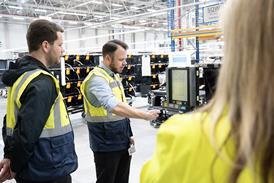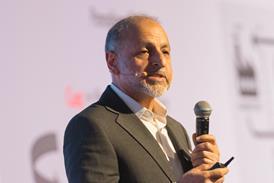A new automotive programme – Inovar-Auto – intends to increase technology and competitiveness in the Brazilian automotive industry
The automotive industry in Brazil is set to undergo a major transformation, driven by the Inovar-Auto programme. The aim of the initiative is to attract investment, encourage research and local development of new technologies, improve the energy efficiency of products and encourage automotive parts supply chain development in the country. The programme started this year and will be in force until 2017. Manufacturers operating in the country must also keep up with public demand, generated by increased income, for improved comfort and safety in vehicles.

All companies participating in the Inovar-Auto programme, either as importers or local manufacturers, have to improve the energy efficiency of vehicles sold in Brazil by at least 12%. If this target is achieved, companies can receive tax incentives reducing the Tax on Industrialized Products (IPI) by up to two percentage points. Companies operating in the country as importers currently have a quota of vehicles which can be brought from outside Mercosul and Mexico without the tax overcharge. This number will be restricted to a maximum of 4,800 units per year. If this total is exceeded, organisations will be required to pay 30 additional points in the IPI rate in addition to the 35% of import tax.
Those manufacturing companies participating in the Inovar-Auto programme must follow a series of manufacturing steps. Firstly, they must meet at least eight of 12 production processes listed by the government, relating to welding, engine and transmission manufacturing, assembly of electrical systems and painting, among other areas. From 2016, the minimum number of production stages that need to be met is expected to reach ten.
Minimum levels of investment are also required in research, development and engineering. “The Inovar-Auto makes [it] clear that if a company wants to take advantage of the Brazilian market, currently the world’s fourth largest market, [it] is necessary to produce and buy parts locally,” says Luiz Moan, president of Anfavea, the association representing vehicle-makers manufacturing in Brazil.
More specifically, the programme has regional content requirements. Although Inovar-Auto has been in force since January this year, the government has not yet established the best way to trace and regulate the origins of a vehicle’s components. The challenge is to find a way for vehiclemakers to transfer this information to the authorities without making the process too bureaucratic.
Investments & product development
Anfavea estimates that vehicle-makers will invest more than 74 billion reais ($34 billion) in Brazil between 2013 and 2017. According to the organisation, the amount will be applied to the construction of new plants and the modernisation and expansion of those already installed. In addition, the package also includes investments to improve quality and productivity, new product development and the attainment of energy efficiency goals imposed by the programme.
This contribution will range from six billion reais to meet the minimum requirements to 12 billion reais if the companies surpass the purposes with the intention of receiving further discounts on IPI,” suggests Moan. The total calculated by the organisation, based on projects announced by vehicle-makers, also provides for the necessary investments so that local industries can reach the goals in research, development and engineering specified in the new automotive programme. The amount will raise the annual production capacity of the country’s automotive industry from 4.3 million vehicles to 5.7 million units.
A survey by IHS reveals that the push to manufacture vehicles with lower fuel consumption and emissions will result in investments in a number of technologies common in other countries but not widely used in Brazil.
The consultancy projects an investment of about 700 million reais in the development of domestic vehicle systems to privide functions such as fuel-saving Start-Stop ability. The IHS study also indicates that 300 million reais will be invested in tyres with low rolling resistance, while the application of turbochargers for Brazilian engines will require more than 200 million reais.
According to the company, without the energy efficiency goals of Inovar-Auto, the Brazilian automotive industry would probably invest 3.4 billion reais between 2012-2016 in technologies to increase vehicle efficiency. However, with the legislation, this amount will be increased by more than 90% to 6.5 billion reais.
Moan explains that Inovar-Auto is just one of the pillars of a policy for Brazil’s automotive industry. This will be reinforced by two other programmes: Inovar-Autopeças and Exportar-Auto. The former is under negotiation with the government and is intended to strengthen the supply chain to meet the growth in demand expected over the next few years, and to deliver gains in productivity and quality. Exportar-Auto aims to strengthen the global competitiveness of the Brazilian automotive industry so that it produces vehicles able to succeed in other markets. Even before this policy is finalised, Anfavea has set itself a goal that the local industry sells one million vehicles outside Brazil in 2017. This volume is 124% higher than that recorded in 2012.
Antonio Megale, president of AEA, the Brazilian association of automotive engineering and director of government affairs at Volkswagen, believes that by 2017 – the year that sees the end of the Inovar-Auto programme – the local industry will have achieved significant progress. “We have vehicles with a significantly higher technological level, with comfort, new propulsion technologies and much closer to what is produced globally,” he says.
According to Megale, the local manufacturers will apply this level of change to Brazilian vehicles. “Our manufacturing technologies are at a very good level, close to what is done abroad, but with an automation level down abit,” he explains. He believes automation will rise gradually with the arrival of global vehicle platforms to Brazil and the evolution of Brazilian products.
Megale points out that the engineering levels of companies established in Brazil “are moving strongly” to meet the goals of the programme, each with different strategies. He adds that for vehicle-makers with longer established engineering centres in Brazil, the goals are less challenging. “The biggest impact will be on companies that do not have the engineering so structured in Brazil,” he says.
Luiz Moan agrees and points out that some companies have such well established development centres in Brazil that they can sell engineering services to other countries. For example, Ford’s team at its Brazil technology centre leads the global development project for the EcoSport, an SUV sold in several countries. “Innovation is not restricted only to products, but also to production processes. Brazil has an aptitude for it. Some years ago, we pioneered the easing of assembly lines. There are companies that produce up to four models in the same line,” he says, signalling that the country has potential for other productivity jumps.

Vehicle-makers in Brazil will have to adapt quickly to new demands. “There is not much time to achieve goals; it is necessary to run and seek solutions to reduce vehicle fuel consumption”, says Antonio Calcagnotto, director of government relations at Renault Nissan in Brazil. The French-Japanese alliance will be responsible for massive investment in the country in the coming years.
Renault is sinking 1.5 billion reais into increased capacity at its industrial complex in Paraná. Nissan has already invested 2.6 billion reais in Brazil to build a factory in Rio de Janeiro, which will have a production capacity of 200,000 vehicles per year and is scheduled to open in 2014.
Ford is also working to meet the goals of Inovar-Auto. The new generation of Focus, recently launched in Brazil, incorporates the company’s dual-fuel engine featuring direct injection technology for ethanol. Rogelio Golfarb, vice-president of the company in this area, expects the new automotive programme to stimulate the supply chain in Brazil. According to Golfarb, the number of component manufacturers operating in the country is insufficient. “There are not enough suppliers for some components, especially the electronics,” he says. The lack of local manufacturers of these parts goes against the requirement of Inovar-Auto to increase the regional content. According to Golfarb, the demand for more technology will be driven mainly by energy efficiency goals imposed by the programme. “The electronics, much more than mechanics, is what makes the vehicle more efficient,” he observes.





























